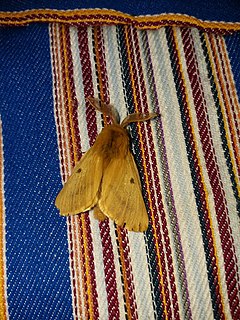
Brahmaeidae is a family of insects in the order Lepidoptera, commonly known as Brahmin moths. It includes species formerly included in the family Lemoniidae.

The Bombycidae are a family of moths. The best-known species is Bombyx mori (Linnaeus) or silkworm, native to northern China and domesticated for millennia. Another well-known species is Bombyx mandarina, also native to Asia.

Apatelodidae, the American silkworm moths, is a family of insects in the order Lepidoptera. They are a family within the superfamily Bombycoidea.

Lemonia dumi is a species of moth of the family Brahmaeidae. It is found in scattered populations in Central Europe.

Lemonia taraxaci, the autumn silkworm moth, is a species of moth of the family Brahmaeidae. It was first described by Michael Denis and Ignaz Schiffermüller in 1775 and it is found in south-eastern Europe.

Lemonia philopalus is a species of moth of the family Brahmaeidae. It is found from Spain up to Egypt and North Africa.

Lemonia vallantini is a species of moth of the family Brahmaeidae. It is found in Morocco, Algeria and Tunisia.

Lemonia is a genus of moths in the family Brahmaeidae (older classifications placed it in the separate family Lemoniidae.
Lemonia ballioni is a species of moth of the family Brahmaeidae. It was described by Hugo Theodor Christoph in 1888. The range includes Turkey, Ukraine and Russia.
Lemonia beirutica is a species of moth of the family Brahmaeidae. It was described by Franz Daniel in 1965. The range includes Israel and Lebanon.
Lemonia pauli is a species of moth of the family Brahmaeidae. It was described by Otto Staudinger in 1894. Its range includes Israel, Syria, Jordan and Lebanon.

Lemonia peilei is a moth in the family Brahmaeidae. It was described by Walter Rothschild in 1921.
Lemonia pia is a moth in the family Brahmaeidae. It was described by Rudolf Püngeler in 1902.
Lemonia ponticus is a moth in the family Brahmaeidae. It was described by Per Olof Christopher Aurivillius in 1894.
Lemonia sacrosancta is a moth in the family Brahmaeidae. It was described by Rudolf Püngeler in 1902.
Lemonia sardanapalus is a moth in the family Brahmaeidae. It was described by Otto Staudinger in 1887. It is known from Turkmenistan.
Lemonia strigata is a moth in the family Brahmaeidae. It was described by Hans Rebel in 1910. It is also listed as a synonym of Lemonia taraxaci.
Hemileuca oliviae, the range caterpillar, is a species of insect in the moth family Saturniidae. It is found in Central America and North America.

Hemileuca juno, the Juno buck moth, is an insect in the family Saturniidae. The species was first described by Alpheus Spring Packard in 1872. It is found in Central and North America.
Coloradia luski, or Lusk's pine moth, is a species of insect in the family Saturniidae. It was first described by William Barnes and Foster Hendrickson Benjamin in 1926 and it is found in North America.










